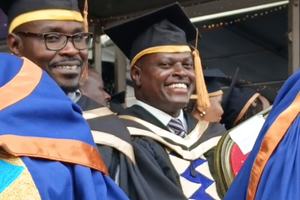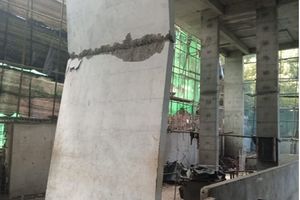
Veteran artist Alan Donovan, founder of African Heritage House, on August 1, 2015. He died died peacefully in his sleep on the morning of December 5, 2021 at his home in Athi River.
| File | Nation Media GroupNews
Premium
Veteran artist Alan Donovan’s last moments
Veteran artist and cultural archivist Alan Donovan was still alive at 4am on Sunday, African Heritage Estates manager Tom Otieno confirmed.
Speaking to the Nation by phone, Mr Otieno said Donovan left him a message in the wee hours, reminding him of their meeting on Sunday at 9am.
Mr Otieno had not been to work since Wednesday because he was unwell.
"Donovan would wake up early and have his breakfast at the same spot he has for years, but on this day, one of the guys noticed he had not woken up and decided to take him the breakfast," he said.
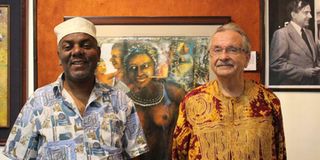
Mr Donovan (right) with Dr Ahmed Yasin who was a director of the National Museum of Kenya.
Lived alone
Donovan lived alone in his house, but he had other people in the compound.
"He was a light sleeper, so when the guy took the breakfast and opened his bedroom, and Donovan did not wake up, this prompted the guy to get closer to wake him up; he touched him, but Donovan did not move, and that is when they called me," he said.
According to Mr Otieno, Donovan was in good health the last time they were together. A post-mortem will be carried out on Tuesday to establish the cause of death.
Donovan, born in Colorado, USA, 83 years ago, played a unique role in the cultural affairs of Kenya and the African continent by dedicating his life to collecting art and preserving the African heritage.
The co-founder of African Heritage, the continent's first Pan-African gallery in Nairobi, which became a pioneering craft retail and wholesale operation, came to Kenya more than 50 years ago.
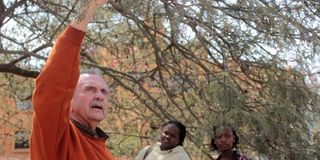
Mr Donovan with students of Strathmore University.
Relief officer
On July 4, 1967, Donovan arrived in Africa as a relief officer with the US State Department during the Nigerian-Biafra war. He resigned in 1969 and travelled to Kenya through the Congo.
Together with former Kenyan Vice President Joseph Murumbi, his wife, Sheila Murumbi, Donovan co-founded African Heritage -- the gallery that boasts of the largest Kenyan and African artefact collection -- in 1972.
Donovan spent his entire life documenting and telling stories of Africa. He met the Murumbis in 1970 at the opening of an exhibition on indigenous Turkana artifacts he had collected.
They chose the Nimba mask from Guinea as the logo displayed on all African Heritage shopping bags, receipts, and letterheads. The company was the largest exporter of arts and crafts from Africa to the rest of the world for several decades.
Donovan organised Pan African Festivals, the first being the Madagascar Music & Arts Festival in 1971, followed by the Nigerian Festival in 1972. He also organised the largest street festival ever held in Nairobi for the city's centennial celebrations in 1997, and a few years later, a tour of 23 Kenyan hotels to bring in the millennium.
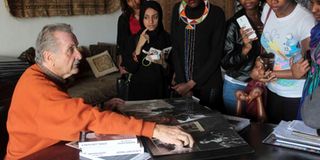
Mr Donovan shows some artifacts to Strathmore University students .
Gallery burnt down
In 1976, the African Heritage gallery burnt down, and they had to find a new home for the African Heritage Gallery.
In 1977, Murumbi sold the government his collection and house in Muthaiga, and instructed the Kenyan government to set up a Murumbi Institute of African Studies.
The United Nations Educational, Scientific and Cultural Organisation (Unesco) agreed to buy an adjoining plot even larger than Murumbi's, and fund the construction of a library, a hostel for students, and kitchens for The Murumbi Pan-African Studies Centre.
Murumbi then moved on to a site near the Maasai Mara National Reserve. By the time Murumbi died in 1990, and his wife in 2000, the government had not set up the research centre with their collection as promised.
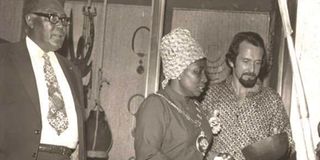
From left: Joseph Murumbi, former mayor of Nairobi Margaret Kenyatta and Mr Alan Donovan during the opening of the original African Heritage on Kenyatta Avenue.
Murumbi's house, with his collection and archive inside, were left to fall apart, and in the end, all the surviving books, documents, and other collections from the house were removed and transferred to the Kenya National Archives.
The house was demolished, and the property sold to individuals under suspicious circumstances.
This whole time, Donavan concentrated on writing Murumbi's legacy beyond the business of the African Heritage. Donavan, who was also involved in the legal and administrative processes of the couple, set up the Murumbi Trust in 2003.
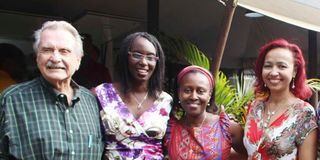
Mr Alan Donovan with some of Point Zero friends.
Together with friends, they looked for funds and found a home for the Murumbi collection.
Under his direction, the trust rehabilitated, repaired, and displayed the Murumbi legacy at The Murumbi Gallery in the Kenya National Archives, The Nairobi Gallery at the old PC's office in Nairobi's City Centre, and a sculpture garden at the Murumbi Peace Memorial in Nairobi City Park.
In 2004, Donovan opened to the public the African Heritage House, which has some of the objects he co-owned with Murumbi.
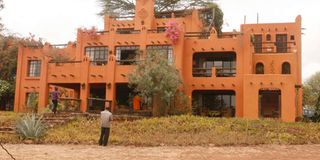
Alan Donovan's African Heritage House. It is said to be the most photographed house in Africa.
Termed the "most photographed house in Africa", the house stands on a slope overlooking the Nairobi National Park, with the Kenya-Uganda railway cutting in between.
The house's four floors are packed from floor to ceiling with African art.
In 2014, the house was threatened with demolition during construction of the standard gauge railway line. At the time, it was being considered for national monument status. It was finally gazetted as a national monument in January 2016.
In 2015, Donovan released A Path Not Taken, the Story of Joseph Murumbi, based on Murumbi's transcripts.
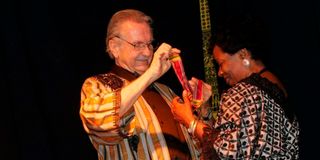
Mr Alan Donovan presents the OBE from the Queen of England to Magdalene Odundo in 2011. She was honoured for her work in ceramics.
Over the years, Donavan wrote to the national and the county government to try and put in place a mechanism to protect his work before he died. When he saw that that was not forthcoming, Donavan put the house up for sale in May this year.
"I hope to pass on the house with all of its rare and valuable contents collected over the last 50 years to a buyer or buyers who will preserve the house as a national monument. Having a board of trustees for the house will not be enough. It must have permanent ownership by people who will nurture it. I hope to find compatible buyers with whom I can continue working on a museum and Pan-African Studies Centre near the house," Donovan had said.
According to Mr Otieno, some people had shown interest in the house, but Donovan had not found a suitable person for it.
"As he had said, he was looking for someone who would nurture the house and its history, but at the time of his death, no one had qualified as a buyer," said Mr Otieno.
Donovan is survived by his sister, who lives in the US.



